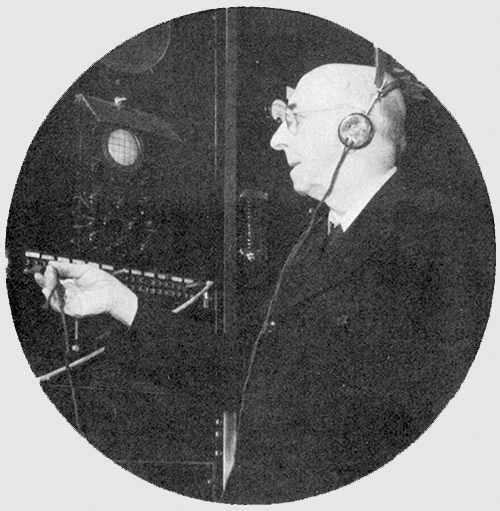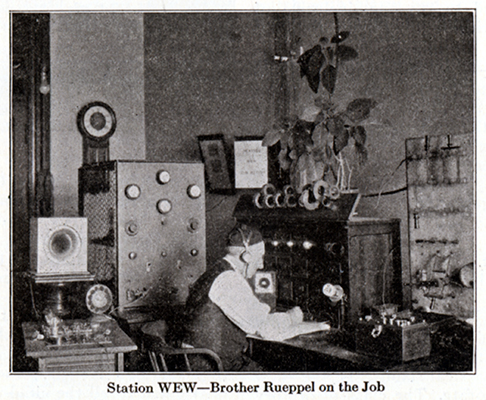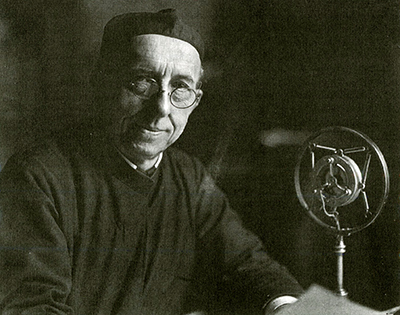St. Louis Cultural History Project—Spring 2021
Brother George Rueppel, S. J.: The Father of St. Louis Radio
By John Waide, M.A.

St. Louis is often called a baseball town.
The St. Louis Cardinals, one of the nation's oldest and most successful professional baseball clubs, have won eleven World Series championships, the most of any team in the National League, and second in Major League Baseball to the storied New York Yankees. The Cardinals have rabid fans all across the United States, and these fans are often called the best fans in baseball.
But St. Louis might also be called a radio town.
KSD radio (now KTRS) was among the earliest radio stations in the United States when it began broadcasting in 1921, and it was one of the first eight stations of the NBC Red (Radio) Network. The original KSD Radio was owned by the Pulitzer Company which owned the St. Louis Post-Dispatch newspaper.
In 1926, radio station KMOX, the Voice of St. Louis,
began broadcasting as a 50,000 watt clear-channel station with a non-directional signal, meaning it could be heard pretty much all across the United States. That same year, KMOX broadcast the St. Louis Cardinals-New York Yankees World Series games, and the next season, 1927, KMOX began airing all St. Louis Cardinals baseball games, and it continues to broadcast Cardinals games today. In fact, the powerful reach of KMOX’s signal is one of the reasons given for the Cardinals having so many fans all across the country.
Yet several years before there was a KSD radio station, or the NBC Network, or the 50,000 red-hot watts of KMOX,
there was another radio station
here in St. Louis. It had odd designations such as 9XY and 9YK and finally WEW, but this early station was always associated with Saint Louis University. And there was one man at Saint Louis University who was always associated with that radio station, and that man was George Rueppel.
George Rueppel was born in Rothenback, Bavaria in Germany, on July 23, 1864. Rueppel and his family moved to the United States in the late 1870s to flee the anti-Catholic sentiment in Germany espoused by Chancellor Otto von Bismarck. He joined the Society of Jesus in 1882 and was trained as a librarian. His first major assignment was at Canisius College in Buffalo, N.Y., where he taught and was a librarian. Although he was well-educated, Rueppel did not follow the suggestion of his Jesuit spiritual father to study for the priesthood. He took his vows as a coadjutor brother. Rueppel was devloping a keen interest in sciences, especially meteorology and geophysics, and he was the director of the Canisius observatory from 1886 to 1894. In his spare time, he became a licensed telegraph operator. Those interests eventually guided him toward his role as a radio pioneer.
Brother Rueppel left Canisius and Buffalo in 1894. He went first to St. Ignatius College (John Carroll) in Cleveland where he helped Father Frederick Odenbach establish a meteorological observatory. He then went to the Jesuit’s St. John’s College in Toledo where he established another meteorological station. In 1908, Brother Rueppel left St. John’s and came to Louis. Almost immediately upon his arrival at Saint Louis University, Brother Rueppel began urging the University to re-establish its own meteorological observatory. The result of Brother Rueppel’s efforts was the creation of the Geophysical Observatory of Saint Louis University in 1910. On January 1, 1910, the meteorological observatory began routine observations as a cooperative station of the U.S. Weather Bureau. Brother Rueppel recorded also the hourly temperatures and afterward transferred to these registers all significant data, including these hourly temperatures, wind direction, and velocity.
In addition to his interest in meteorology, Brother Rueppel was also developing expertise in physics, geophysics, and telegraphy. He had received training in telegraphy and on occasion trained others in how to operate a telegraph machine. Brother Rueppel always insisted that his entry into radio was a happy accident growing out of his knowing how to operate a telegraph.
In 1912, Saint Louis University set up a wireless station for the purpose of communicating with other Jesuit seismological stations around the country and to send out weather reports from its meterological observatory. Brother Rueppel started sending out wireless weather reports in Morse code to train stations and farm bureaus around the country. The telegraph operators in these stations would translate the code and then read it to local farmers who would gather together to hear the reports.
By February 1915, the University had been issued a license to operate a Technical and Training School
station, and it was assigned the call sign of 9YR. In May 1916 this station's license was changed to an Experimental
authorization, with a new call sign of 9XY. However, with the entrance of the United States into World War I in 1917, all civilian stations were ordered to halt operations, and the University's radio station was shut down for the duration of the conflict. During the War, the University trained over 300 radio operators for the United States Army.
When the War ended, Saint Louis University was again issued a Technical and Training School
license, now with the call sign of 9YK, and Brother Rueppel resumed his duties with the new station. During the war, advances in vacuum tube design made audio transmissions practical, and 9YK was upgraded to take advantage of this new technology. In late March 1921, it was announced that the United States Weather Bureau, in conjunction with the SLU Department of Science, had received permission from Washington authorities to make twice-daily broadcasts of the official weather. By this time, so many individuals or groups were making broadcasts over the air t1921, that the U.S. Department of Commerce began regulating the medium and started issuing licenses.
And so it was that the University’s 9YK station became the second radio station in the United States, and first west of the Mississippi River, to get an official license.This new radio service made its debut over 9YK at 10:05 a.m. on April 26, 1921, when the Saint Louis University President Father William Robison, S.J., made an introductory statement, then read a 500-word Weather Bureau bulletin.
By March, 1922, the University was issued a broadcasting station authorization, and it received the randomly assigned call letters of WEW. Brother Rueppel’s personal interpretation of the new call letters was We Enlighten the World.
And for the next quarter century, Brother Rueppel did everything he could to enlighten everyone with his work at the station.
Ruepple was literally everywhere doing everything. The station’s studios were housed on the top floor of the University’s Law School in O’Neil Hall. The the transmitter tower, which was torn down in 1954, was located roughly where Pius XII Memorial Library now stands. Brother Rueppel was the station’s engineer, station manager, program director, continuity writer, platter turner, announcer, talent scout, auditioner, and star performer.
The station was required by the Government to carry six hours of broadcasting per day to keep its license. As this was difficult to do broadcasting only news and weather reports, Brother Rueppel would play music by bringing in his own phonograph and placing a microphone in front of the machine. To add even more variety to the station’s schedule, he Rueppel nserted Aunt Sammy's Prize Recipes,
and, for a little while each morning, he was the local cooking authority Aunt Sammy.
With the assistance of Jesuit seminarians, he began a weekly Question Box Hour.
The questions usually dealt with religious matters. Later the nationally known author, Father Daniel Lord, answered the questions sent in by mail. At the request of disabled World War I veterans staying at Koch Hospital near Jefferson Barracks, Brother Rueppel broadcast the Sunday Mass and sermon from the St. Francis Xavier College Church.
He began a Day's Dedication
Program that eventually evolved into the Sacred Heart Program. At its height, the Program reached over a thousand outlets in fourteen countries and the Armed Services Network.
Brother George Rueppel passed away in St. Louis on May 31, 1947. Few people in St. Louis today recognize Brother Rueppel’s name. Even though he worked at Saint Louis University for nearly 40 years, there are no markers on campus, or scholarships or memorials at the University in his name. There was a building named after him for a while, but it was demolished more than 50 years ago. Yet if one could select someone as The Father of St. Louis Radio,
George Rueppel would probably be the choice for that honor.


